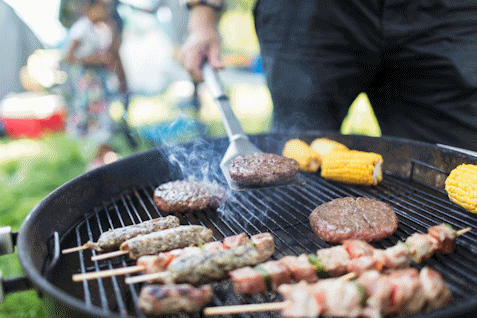
Holiday Cookery
 July 4th is a big barbecue
occasion here in the United States. Picnic tables everywhere are done up in red, white and blue color schemes and cakes decorated to look
like the U.S. flag. And of course, what's a barbecue without an ample supply of hamburgers, hot dogs and potato salad.
July 4th is a big barbecue
occasion here in the United States. Picnic tables everywhere are done up in red, white and blue color schemes and cakes decorated to look
like the U.S. flag. And of course, what's a barbecue without an ample supply of hamburgers, hot dogs and potato salad.
As you already know, summer requires that a bit of extra care be taken when handling and processing food. Here are some tips on keeping food safe.
| 1. | Keep foods cold. When serving perishable foods such as luncheon meats, cooked meats, chicken, potato or pasta salads, keep them in an insulated cooler packed with several inches of ice, ice packs or containers of frozen water. Pack beverages in a separate cooler from your other foods as the beverage cooler will most probably be opened more frequently. Keep the cooler out of the sun and if the ice begins to melt, add more. |
| 2. | Plan ahead. If fast foods are a part of your menu, buy them just before you leave on your outing. Food not refrigerated for more than 2 hours may not be safe to eat. If it's above 90 degrees outside, food should not be left out longer than 1 hour. |
| 3. | Wash your hands before handling food. |
| 4. | Cook foods thoroughly. Follow internal temperature guidelines as you would when roasting or baking indoors. If food is to be cooked on a grill, be sure that coals are lightly coated with ash. |
| 5. | Don't cross contaminate. Keep raw food and cooked foods separate from each other and never put cooked food back on a plate where raw food was kept. |
How to Select a Good Watermelon
One of the best things about summer is a picnic with a ripe, juicy watermelon. Real Simple suggests the following tips on how to select a good one.
1. The color of the watermelon is vital indicator as to its ripeness. The dark green stripes should be a deep, dark green and the pale stripes a creamy, light yellow. You may also want to pick a "duller" looking one as a very shiny watermelon may not be ripe.
2. Find the "field spot" on the bottom, the spot where the watermelon laid on the ground. A creamy, yellow to orange suggests the melon is ripe. If it's white or a light yellow, choose another one.
3. Knock on it. A deep and hollow sound indicates the fruit has more water and is likely ripe. A higher pitched and denser sound may indicate thta the fruit is not fully ripened.
4. Look for spots on all sides of the fruit. Dry weathering spots and veins are indicators of an extra sweet watermelon. These spots show where sugar has been seeping ot of the fruit.
5. Choose the heaviest one for it's size. A watermelon should feel heavier than it looks; the more dense the higher water content resulting in a sweeter watermelon.
6. Choose a round one over an oval shaped one. The rounder melons are supposedly sweeter. (This one I'm not too sure about.)
Copyright 1998-2024
All Rights Reserved